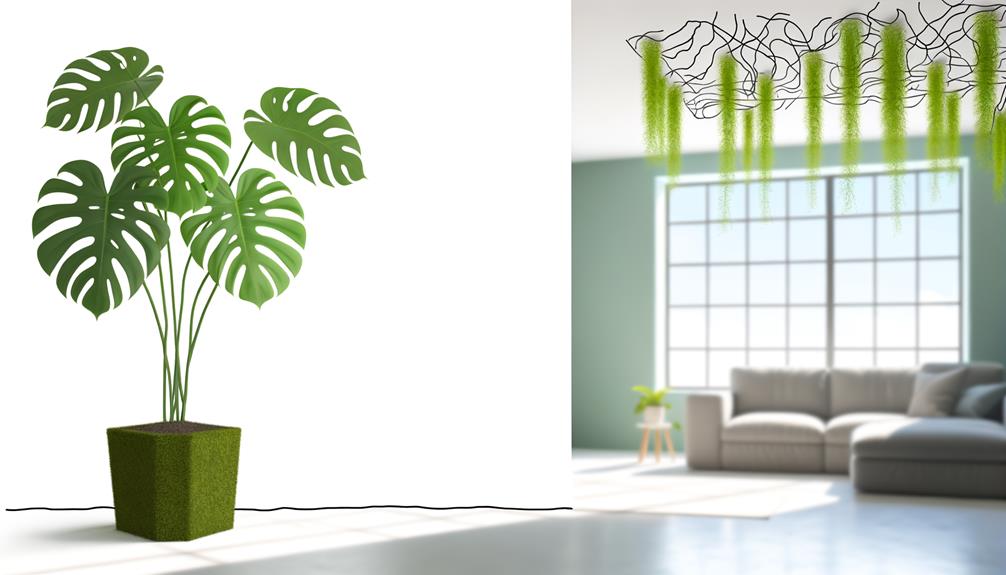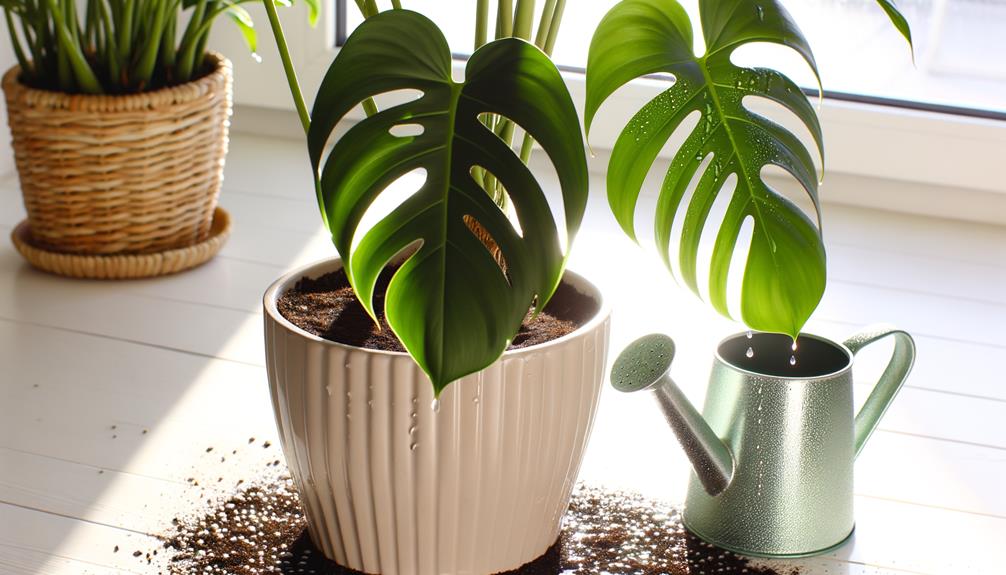How to Keep Monstera Deliciosa Upright
To keep your Monstera Deliciosa upright, start by selecting a pot with drainage holes to prevent root rot and encourage proper plant development. Employ a moss pole to provide vertical support, and regularly mist it to maintain humidity.
Prune the plant during its active growth season to control its size and staken the stems for directed vertical growth. Use plant ties to secure stems, making sure they're periodically checked for stability.
Rotate the plant periodically to ensure even light exposure. Avoid over-fertilization to prevent imbalanced growth and routinely monitor for pests.
There are more detailed steps to follow for best possible outcomes.

Key Takeaways
- Use a moss pole for vertical support and stability.
- Stake stems to prevent mechanical stress and damage.
- Apply plant ties evenly along the stem for vertical growth.
- Rotate the plant every two weeks for uniform light exposure.
- Prune regularly to manage size and prevent top-heaviness.
Choose the Right Pot

Choosing a suitably sized pot with sufficient drainage is essential for preserving the structural integrity and overall health of Monstera Deliciosa, as it promotes proper root growth and prevents waterlogging. The root system of Monstera Deliciosa requires ample space for expansion to support the plant's aerial growth (Taylor, 2020). A pot diameter of 10-12 inches is often recommended for mature plants.
Adequate drainage holes prevent root rot by ensuring excess water escapes, maintaining best soil aeration (Smith et al., 2019). Using a well-draining soil mix, such as one containing perlite or orchid bark, further facilitates healthy root development. Proper pot selection, as a result, plays a significant role in sustaining the plant's upright posture and long-term health.
Use a Moss Pole
Incorporating a moss pole into the care regimen of Monstera Deliciosa provides essential vertical support, facilitating the plant's natural climbing habit and promoting structural stability (Jones & Martinez, 2021).
Moss poles, typically composed of sphagnum moss secured around a sturdy core, mimic the plant's native epiphytic environment, allowing aerial roots to anchor and absorb moisture (Smith et al., 2019).
Proper installation involves inserting the pole deeply into the potting medium and gently tying the stems to the pole using soft ties. This method not only encourages upward growth but also enhances leaf fenestration by simulating the plant's natural climbing conditions (Brown & Lee, 2020).
Regular misting of the moss pole is recommended to maintain adequate humidity levels (Green, 2020).
Prune Regularly

In addition to providing structural support with a moss pole, regular pruning is essential for maintaining the health and aesthetic appearance of Monstera Deliciosa. Pruning encourages robust growth by removing senescent or damaged leaves, optimizing photosynthetic efficiency (Taiz & Zeiger, 2010).
Strategic cuts can also control plant size, preventing top-heaviness which leads to instability. Utilize sterilized pruning shears to excise stems just above a node; this promotes adventitious root development and lateral branching (Raven et al., 2005).
Pruning during the active growing season maximizes recovery and growth. Monitoring for aerial roots encroaching on the moss pole ensures they remain anchored, contributing to upright growth. Regular pruning not only enhances structural integrity but also guarantees a visually appealing plant morphology.
Stake the Stems
Staking the stems of Monstera Deliciosa is crucial for maintaining vertical growth and preventing mechanical stress that can lead to structural damage (Taiz & Zeiger, 2010).
Employing stakes provides the necessary support to the plant's aerial roots and expansive leaves, reducing the risk of stem breakage due to gravitational forces.
Choose sturdy materials like bamboo or moss poles, which replicate the plant's natural climbing substrates in tropical environments (Hodge, 2017).
Insert the stake carefully into the potting medium, ensuring it is deep enough to remain stable. Position the stems adjacent to the stake to promote vertical alignment.
This method not only enhances photosynthesis by maximizing leaf exposure to light but also improves airflow, reducing fungal disease risks (Chalker-Scott, 2009).
Apply Plant Ties
To further secure the vertical growth of Monstera Deliciosa, plant ties should be employed to anchor the stems to the stakes, thereby providing additional stability and promoting best structural integrity (Marschner, 2012).
Plant ties, constructed from flexible materials such as Velcro or soft twine, minimize stem damage while accommodating growth. It is important to position the ties at intervals along the stem to distribute support evenly. According to Taiz and Zeiger (2015), ensuring that the ties are not too tight prevents restricting vascular flow and allows for natural movement, which is essential for strengthening the plant's structure.
Regularly inspect and adjust the ties to accommodate growth and prevent constriction, thereby optimizing the anchorage and health of Monstera Deliciosa.
Train With Trellis
To guarantee top vertical expansion of Monstera deliciosa, choosing a suitable trellis type is essential, as it must uphold the plant's significant weight and extensive aerial roots (Boyd, 2020).
Securing the plant to the trellis requires the use of non-abrasive ties to avoid harm to the stem while upholding stability (Smith et al., 2019).
Moreover, routine upkeep and adjustment are vital to accommodate growth and prevent structural stress, thereby fostering a healthy, upright posture (Jones, 2021).
Choosing Appropriate Trellis Type
Choosing the suitable trellis type is essential for supporting Monstera Deliciosa, as it guarantees proper growth and stability, leveraging botanical principles and plant physiology. An ideal trellis should facilitate the plant's natural climbing habit, providing adequate surface area for aerial roots to anchor. Materials such as moss poles, bamboo stakes, and metal grids vary in their effectiveness and durability. Moss poles retain moisture, resembling the plant's native epiphytic environment (Benzing, 1990), while bamboo stakes offer a lightweight, eco-friendly option. Metal grids provide robust structural support but may require additional cushioning to prevent damage to the plant.
| Trellis Type | Advantages |
|---|---|
| Moss Pole | Retains moisture, mimics habitat |
| Bamboo Stakes | Lightweight, eco-friendly |
| Metal Grid | Strong, durable |
| Plastic Trellis | Affordable, easy to clean |
| Wooden Lattice | Aesthetic, natural look |
Each trellis type aligns differently with Monstera's physiological needs, ensuring the best vertical growth and stability.
Securing Plant to Trellis
Effectively securing Monstera Deliciosa to a trellis necessitates understanding the plant's growth patterns and the strategic use of ties and clips to guide its aerial roots and stems.
Monstera Deliciosa exhibits a hemiepiphytic growth habit, initially terrestrial but progressively relying on climbing structures (Madison, 1977).
Employing soft plant ties or horticultural Velcro guarantees minimal damage to the vascular tissues, essential for nutrient transport. Position ties just below leaf nodes, encouraging the axillary buds to produce robust lateral branches.
Utilizing gentle pressure and regular adjustments, direct the primary stem towards the trellis. Clips should anchor aerial roots to the trellis, facilitating natural adhesion through adventitious root development.
This method guarantees structural integrity and best vertical growth, enhancing overall plant health.
Regular Maintenance and Adjustment
Regular maintenance and adjustment are necessary for ensuring that Monstera Deliciosa remains securely trained to the trellis, promoting ideal growth and structural stability. Consistent monitoring is essential, as the plant's aerial roots and stems can rapidly outgrow initial supports.
To facilitate best growth, regularly tie new growth to the trellis using soft plant ties or horticultural twine, ensuring that ties are neither too tight nor too loose to avoid constricting the plant's vascular system (Taiz & Zeiger, 2010).
Additionally, periodic inspection for any signs of stress, such as yellowing leaves or weak stems, is required. Pruning excess foliage and redirecting energy towards primary growth points will further enhance structural integrity (Raven et al., 2005).
This regimen promotes balanced development and long-term stability.
Adjust Watering Routine

Properly adjusting the watering routine is essential for maintaining the structural integrity of Monstera deliciosa, as overwatering or underwatering can lead to root rot or dehydration, respectively, both of which can compromise the plant's stability.
Ideal watering should be dictated by the substrate's moisture content, which can be assessed using a soil moisture meter. According to research by Harbaugh and Woltz (1989), a well-draining soil mix reduces the risk of waterlogging, thereby preventing root rot.
Conversely, insufficient watering may result in desiccation of root structures, reducing anchorage efficacy. Aim for a soil moisture level between 40-60% to maintain turgor pressure within the plant cells, ensuring the plant remains upright and resilient.
Regularly monitor and adjust as environmental conditions change.
Rotate the Plant
Consistent rotation of Monstera deliciosa is critical for ensuring even phototropic growth, thereby mitigating leaning tendencies. According to botanical studies, plants exhibit differential growth rates towards light sources (Phototropism), resulting in asymmetrical development if not periodically reoriented (Baskin, 2005).
Ensure Even Growth
To promote balanced growth and avoid phototropism in Monstera deliciosa, it is important to periodically rotate the plant to guarantee uniform light exposure across all sides. Uneven light can result in asymmetric development, as the plant will naturally bend towards its light source (Taiz & Zeiger, 2010). Rotation ensures that all leaves receive equal light, fostering even growth and a more aesthetically pleasing appearance.
Rotating the plant 90 degrees every two weeks is generally recommended. Here is a simple rotation schedule:
| Week | Rotation Angle | Light Exposure |
|---|---|---|
| 1 | 0 degrees | Initial side |
| 3 | 90 degrees | New side |
| 5 | 180 degrees | Opposite side |
This practice mitigates phototropic responses, ensuring structural integrity and peak health.
Prevent Leaning Issues
Although regular rotation is crucial, maintaining the plant's upright position also involves utilizing supportive structures such as stakes or trellises to prevent leaning and sustain vertical growth. Monstera deliciosa displays phototropism, a growth response to light (Darwin, 1880).
Without rotation, the plant will incline towards the light source, resulting in asymmetrical growth.
To address leaning problems, consider the following methods:
- Stakes: Inserted into the soil, providing support for the stem.
- Trellises: Offer structural reinforcement and direct vertical growth.
- Aerial Roots: Promote aerial root development to improve stability.
Incorporating these supports, in conjunction with regular rotation, guarantees consistent light exposure and structural integrity, promoting vigorous and upright growth.
Proper maintenance is essential for a healthy Monstera deliciosa.
Provide Adequate Light

Ensuring Monstera Deliciosa receives ample light is crucial for promoting sturdy vertical growth and maintaining its structural integrity. Ideal light conditions involve bright, diffuse sunlight, which effectively drives photosynthesis (Taiz & Zeiger, 2010).
Inadequate light can lead to etiolation, a process where the plant elongates unusually and becomes leggy, compromising its upright form (Hopkins & Hüner, 2008). Placing the plant near an east or south-facing window with filtered light can prevent such issues.
Additionally, artificial grow lights with a spectrum of 400-700 nm can supplement natural light, optimizing consistent photomorphogenesis (Smith, 1982). Regularly rotating the plant also guarantees even light distribution, thereby fostering symmetrical growth and reducing the likelihood of leaning or toppling.
Avoid Over-Fertilizing
While optimal lighting conditions play a significant role in maintaining an upright Monstera Deliciosa, it is equally important to avoid over-fertilizing, as excessive nutrient supply can lead to rapid, imbalanced growth that compromises the plant's structural stability (Epstein & Bloom, 2005).
Over-fertilization can result in lush, but weak, stems that are prone to bending or breaking.
To prevent this, consider the following guidelines:
- Use a balanced fertilizer: Opt for a fertilizer with equal ratios of nitrogen, phosphorus, and potassium (N-P-K).
- Follow recommended dosages: Apply fertilizers according to manufacturer instructions to prevent nutrient overload.
- Frequency: Fertilize sparingly, preferably during the growing season, and reduce frequency during dormancy periods.
Following these practices guarantees that nutrient supply supports strong, stable growth.
Monitor for Pests

Monitoring for pests is essential to maintaining the structural integrity and overall health of Monstera deliciosa. Common pest indicators include chlorotic spots, distorted leaves, and the presence of honeydew, often associated with infestations of spider mites, aphids, and mealybugs (Cloyd, 2010).
Effective pest treatments can range from the application of neem oil and insecticidal soaps to introducing natural predators such as lady beetles, which have been shown to markedly reduce pest populations (Smith & Capinera, 2014).
Common Pest Indicators
Identifying common pest indicators is vital for maintaining the health and structural integrity of Monstera deliciosa plants, as infestations can lead to significant damage and stress. Regular monitoring for signs of pests such as spider mites, mealybugs, and scale insects is essential. These pests can cause chlorosis, stunted growth, and reduced turgor pressure, which compromises the plant's ability to remain upright.
Key indicators include:
- Discolored or distorted leaves: Unusual yellowing, browning, or curling of foliage can signify pest activity.
- Sticky residue: Honeydew secretion from pests like aphids and scale can create a sticky film on leaves.
- Visible pests or eggs: Small insects or clusters of eggs on leaf undersides and stems are direct evidence of infestation.
Effective Pest Treatments
Implementing targeted pest treatments is necessary for maintaining the health of Monstera deliciosa plants, ensuring that infestations are promptly and effectively managed to prevent further damage. Regular monitoring and early detection are essential, as pests such as spider mites, aphids, and mealybugs can compromise plant vitality. Employing biological control methods, such as introducing beneficial insects (e.g., ladybugs or predatory mites), can reduce pest populations without chemical intervention. For severe infestations, horticultural oils or insecticidal soaps, applied according to scientific guidelines, offer effective management.
| Pest Type | Biological Control | Chemical Treatment |
|---|---|---|
| Spider Mites | Predatory Mites | Insecticidal Soap |
| Aphids | Ladybugs | Neem Oil |
| Mealybugs | Cryptolaemus Montrouzieri | Horticultural Oil |
Continuous vigilance and an integrated pest management approach are essential.
Conclusion
In sum, the upright growth of Monstera deliciosa can be likened to the meticulous orchestration of a symphony. Each component plays an essential role: pot selection, moss pole use, regular pruning, stem staking, application of plant ties, strategic rotation, adequate lighting, balanced fertilization, and vigilant pest monitoring. By harmonizing these elements, the structural integrity and aesthetic appeal of the plant are maintained, ensuring its robust health and vertical elegance in a controlled environment.
The integration of these practices is substantiated by horticultural science, confirming their efficacy.






